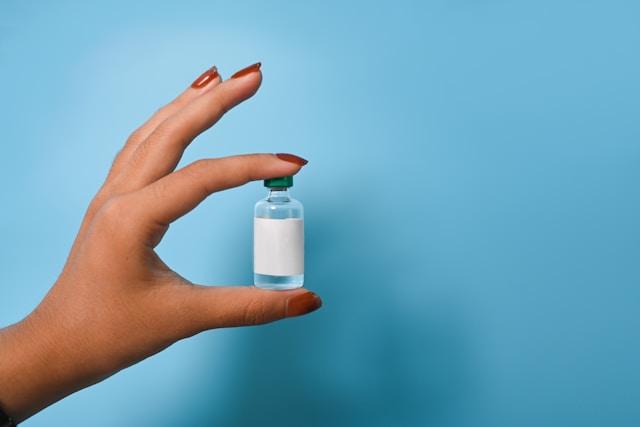[Disclaimer: This article is for informational purposes only and does not constitute medical advice. Always consult with a qualified healthcare provider before starting any peptide therapy.]
The science behind peptide therapy for endurance athletes reads like something from a sports medicine textbook that’s being written in real time. These short chains of amino acids are quickly becoming the talk of locker rooms and training facilities worldwide.
Researchers are uncovering how these molecular messengers might influence everything from tissue repair and muscle growth to energy metabolism, but we’re still in the early chapters of understanding their true potential.
Let’s break down the seven most promising options that serious athletes are exploring.
Why Are Athletes Using Peptide Therapy?
Before we dive into specific peptides, let’s get something straight. These aren’t your typical supplements you’ll find at the local nutrition store.
Peptides are essentially tiny proteins that can trigger specific biological responses in your body.
Think of them as biological messengers that can tell your cells to heal faster, produce more growth hormone, or optimize how you burn fuel during those long training sessions.
The appeal for endurance athletes is obvious: better recovery means more consistent training, and optimized metabolism means sustained energy when you need it most.
Here’s what sets peptides apart:
- They work with your body’s existing systems rather than against them
- Many target specific pathways related to healing and performance
- They often have fewer side effects than traditional performance enhancers
- Some can accelerate recovery between training sessions
Top 7 Peptides for Endurance Athletes
Here are 7 of the most research-backed peptides used for athletic performance enhancement and endurance capacity.
1. BPC-157: The Recovery Game-Changer
When athletes talk about peptides that could transform their training, BPC-157 usually tops the list. This synthetic peptide comes from a protective protein found in stomach juice, and it’s gained serious attention for helping tissues heal faster.
How BPC-157 Supports Muscle Recovery
What makes this peptide special is how it works on multiple levels. It ramps up growth factors and activates specific cellular pathways that promote tissue repair[1]. For endurance athletes dealing with overuse injuries or chronic inflammation, this could be huge.
The peptide also enhances growth hormone receptor activity, particularly in tendon cells[2]. This means your tendons might respond better to your body’s natural healing signals. Since tendons take forever to heal normally, anything that speeds this up catches athletes’ attention.
BPC-157 also promotes angiogenesis[3], which is just a fancy way of saying it helps form new blood vessels. More blood flow to damaged areas means faster healing and better nutrient delivery during recovery.
Important reality check: Most research on BPC-157 comes from animal studies. Human clinical evidence remains limited, and it’s banned by USADA for competitive athletes. No published research has conclusively shown it directly boosts human athletic performance.
2. The Growth Hormone Power Duo: CJC-1295 + Ipamorelin
The CJC-1925 Ipamorelin combination is like having a conversation between your brain and your muscles about when to release growth hormone. Instead of random spikes and crashes, you get a more controlled, natural-feeling boost.
Why Endurance Athletes Choose This Peptide Combination
CJC-1295 acts like a wake-up call for your pituitary gland, telling it to produce more growth hormone[4]. Ipamorelin then fine-tunes this process, stimulating release without messing with other hormones like cortisol or prolactin[5].
Together, they create several benefits that endurance athletes love:
- Faster recovery between training sessions
- Improved lean muscle mass development
- Better fat metabolism for sustained energy
- Enhanced sleep quality for deeper recovery
The effects build gradually over weeks rather than happening overnight. Most people notice improvements in energy and recovery after consistent use for a few weeks, which aligns well with training periodization.
3. TB-500: When You Need to Heal Fast
TB-500 is synthetic version of Thymosin Beta-4, a peptide that exists in virtually every cell in your body. For athletes who push their bodies to the limit, this could be the difference between training through minor issues and being sidelined.
How TB-500 Enhances Athletic Performance
This peptide works by regulating actin, a protein that’s vital for cell movement and repair[6]. It’s like having a construction foreman directing the rebuilding process after your tissues take a beating during training.
TB-500 also stimulates the formation of new blood vessels and reduces inflammation[7]. For endurance athletes, this translates to:
- Faster recovery from soft tissue injuries
- Improved flexibility and mobility
- Better stamina through enhanced blood flow
- Reduced downtime between intense training blocks
Like BPC-157, TB-500 raises regulatory red flags. WADA has developed detection methods specifically for anti-doping testing, so competitive athletes need to be aware of the rules.
Third-Party Tested, 99% Purity
Order lab-verified peptides from our top recommended vendor.

4. MOTS-c: The Mitochondrial Optimizer
MOTS-c might sound like something from a sci-fi movie, but it’s actually a 16-amino acid peptide that your mitochondria naturally produce. For endurance athletes, this one’s particularly interesting because it directly targets energy production.
Why MOTS-c Matters for Endurance Performance
This peptide activates the AMPK pathway, which is like your body’s energy sensor[8]. It helps regulate glucose metabolism in skeletal muscle, potentially making you more efficient at using fuel during long efforts.
Research shows some impressive results. In mice, a single dose improved running time by 12% and distance by 15%. The peptide accumulates in trained muscle after several weeks of exercise, suggesting it plays a role in training adaptations[9].
Here’s the interesting twist: professional athletes actually tend to have lower MOTS-c levels than sedentary people. High-level endurance athletes show even lower levels than moderate exercisers. This suggests that chronic training might change how your body uses this peptide.
5. AOD9604: The Fat-Burning Specialist
AOD9604 takes a different approach. Instead of focusing on muscle repair or growth hormone, it zeroes in on fat metabolism. For endurance athletes who want to optimize their power-to-weight ratio, this could be game-changing.
How AOD9604 Helps Athletes Use Peptides for Body Composition
This peptide targets specific receptors involved in fat breakdown, essentially telling your body to use more fat for fuel while slowing down fat storage. It increases expression of beta-3-adrenergic receptors, which are the main fat-burning switches in your fat cells[10].
Research shows it can:
- Reduce body weight and fat mass
- Increase energy expenditure
- Improve fat oxidation during exercise
- Help maintain lean muscle mass during weight loss
The catch? AOD9604 is banned by WADA. Detection methods exist for anti-doping testing, so competitive athletes should steer clear.
6. SLU-PP-332: The Exercise Mimetic
SLU-PP-332 represents something completely different in the peptide world. This synthetic compound is designed to mimic some of the benefits of exercise at the cellular level, earning it the nickname “exercise in a pill.”
The Science Behind This Novel Peptide
This compound activates estrogen-related receptors (ERRs) that play important roles in muscle exercise capacity[11]. It essentially tricks your muscles into thinking they’re getting more training stimulus than they actually are.
Research in mice[12] shows it can:
- Enhance exercise endurance when taken for two weeks
- Increase type IIa oxidative muscle fibers
- Improve mitochondrial function
- Activate genes associated with aerobic exercise
The effects depend on having functional ERRα receptors. Mice without these receptors didn’t show performance improvements, confirming the specific pathway this peptide targets.
While promising, research remains in early stages with studies limited to mice. Human applications are still theoretical.
7. GLP-1 Agonists: The Weight Management Option
GLP-1 receptor agonists started as diabetes medications but have caught athletes’ attention for their weight loss effects and potential performance benefits. For endurance athletes struggling with body composition, they offer a different approach.
How GLP-1 Agonists Support Performance and Recovery
These medications mimic a gut hormone that regulates insulin and appetite. For athletes, the benefits go beyond simple weight loss:
- Enhanced fat oxidation during exercise
- Improved glucose regulation for steady energy
- Reduced systemic inflammation
- Better power-to-weight ratios
Research shows GLP-1 can regulate muscle remodeling to enhance exercise endurance through AMPK pathway activation. Studies in mice demonstrate increased glycogen synthesis, glucose uptake, and mitochondrial biogenesis[13].
The major concern: Up to 40% of weight loss on GLP-1 drugs can be lean muscle mass without proper exercise and protein intake. For athletes who depend on muscle mass for power and recovery, this could backfire.
The Reality Check Every Athlete Needs
Here’s the truth about peptide use in sports: most of these compounds lack robust human clinical trials in athletic populations. While the research looks promising, we’re often extrapolating from animal studies or small human trials in non-athletic populations.
Several peptides mentioned here are prohibited by anti-doping agencies. Competitive athletes need to understand the regulatory landscape before considering any peptide therapy.
| Peptide | WADA/USADA Status | Human Research Level |
|---|---|---|
| BPC-157 | Banned | Limited |
| CJC-1295/Ipamorelin | Regulated | Moderate |
| TB-500 | Banned | Limited |
| MOTS-c | Under review | Early stage |
| AOD9604 | Banned | Limited |
| SLU-PP-332 | Not specified | Preclinical only |
| GLP-1 Agonists | Allowed with TUE | Extensive (diabetes) |
Athletes considering these options should work with healthcare professionals experienced in sports medicine. Understanding both the potential benefits and risks, along with legal implications for competitive sport, is essential for making informed decisions.
The field of peptide therapy for athletes continues evolving rapidly. As research progresses, our understanding of efficacy, safety, and appropriate applications will likely improve dramatically.
Related Articles
Safe Peptides For Muscle Building
Peptide Therapy for Women Over 40
Best Peptides for Female Fat Loss
References
- Seiwerth, S., Milavic, M., Vukojevic, J., Gojkovic, S., Krezic, I., Vuletic, L. B., Pavlov, K. H., Petrovic, A., Sikiric, S., Vranes, H., Prtoric, A., Zizek, H., Durasin, T., Dobric, I., Staresinic, M., Strbe, S., Knezevic, M., Sola, M., Kokot, A., Sever, M., … Sikiric, P. (2021). Stable Gastric Pentadecapeptide BPC 157 and Wound Healing. Frontiers in pharmacology, 12, 627533. https://doi.org/10.3389/fphar.2021.627533.
- Chang, C. H., Tsai, W. C., Hsu, Y. H., & Pang, J. H. (2014). Pentadecapeptide BPC 157 enhances the growth hormone receptor expression in tendon fibroblasts. Molecules (Basel, Switzerland), 19(11), 19066–19077. https://doi.org/10.3390/molecules191119066.
- Hsieh, M. J., Liu, H. T., Wang, C. N., Huang, H. Y., Lin, Y., Ko, Y. S., Wang, J. S., Chang, V. H., & Pang, J. S. (2017). Therapeutic potential of pro-angiogenic BPC157 is associated with VEGFR2 activation and up-regulation. Journal of molecular medicine (Berlin, Germany), 95(3), 323–333. https://doi.org/10.1007/s00109-016-1488-y.
- Alba, M., Fintini, D., Sagazio, A., Lawrence, B., Castaigne, J. P., Frohman, L. A., & Salvatori, R. (2006). Once-daily administration of CJC-1295, a long-acting growth hormone-releasing hormone (GHRH) analog, normalizes growth in the GHRH knockout mouse. American journal of physiology. Endocrinology and metabolism, 291(6), E1290–E1294. https://doi.org/10.1152/ajpendo.00201.2006.
- Raun, K., Hansen, B. S., Johansen, N. L., Thøgersen, H., Madsen, K., Ankersen, M., & Andersen, P. H. (1998). Ipamorelin, the first selective growth hormone secretagogue. European journal of endocrinology, 139(5), 552–561. https://doi.org/10.1530/eje.0.1390552.
- Sanders, M. C., Goldstein, A. L., & Wang, Y. L. (1992). Thymosin beta 4 (Fx peptide) is a potent regulator of actin polymerization in living cells. Proceedings of the National Academy of Sciences of the United States of America, 89(10), 4678–4682. https://doi.org/10.1073/pnas.89.10.4678.
- Goldstein, A. L., Hannappel, E., Sosne, G., & Kleinman, H. K. (2012). Thymosin β4: a multi-functional regenerative peptide. Basic properties and clinical applications. Expert opinion on biological therapy, 12(1), 37–51. https://doi.org/10.1517/14712598.2012.634793.
- Yang, B., Yu, Q., Chang, B., Guo, Q., Xu, S., Yi, X., & Cao, S. (2021). MOTS-c interacts synergistically with exercise intervention to regulate PGC-1α expression, attenuate insulin resistance and enhance glucose metabolism in mice via AMPK signaling pathway. Biochimica et biophysica acta. Molecular basis of disease, 1867(6), 166126. https://doi.org/10.1016/j.bbadis.2021.166126.
- Hyatt J. K. (2022). MOTS-c increases in skeletal muscle following long-term physical activity and improves acute exercise performance after a single dose. Physiological reports, 10(13), e15377. https://doi.org/10.14814/phy2.15377.
- Heffernan, M., Summers, R. J., Thorburn, A., Ogru, E., Gianello, R., Jiang, W. J., & Ng, F. M. (2001). The effects of human GH and its lipolytic fragment (AOD9604) on lipid metabolism following chronic treatment in obese mice and beta(3)-AR knock-out mice. Endocrinology, 142(12), 5182–5189. https://doi.org/10.1210/endo.142.12.8522.
- Billon, C., Schoepke, E., Avdagic, A., Chatterjee, A., Butler, A. A., Elgendy, B., Walker, J. K., & Burris, T. P. (2024). A Synthetic ERR Agonist Alleviates Metabolic Syndrome. The Journal of pharmacology and experimental therapeutics, 388(2), 232–240. https://doi.org/10.1124/jpet.123.001733.
- Billon, C., Sitaula, S., Banerjee, S., Welch, R., Elgendy, B., Hegazy, L., Oh, T. G., Kazantzis, M., Chatterjee, A., Chrivia, J., Hayes, M. E., Xu, W., Hamilton, A., Huss, J. M., Zhang, L., Walker, J. K., Downes, M., Evans, R. M., & Burris, T. P. (2023). Synthetic ERRα/β/γ Agonist Induces an ERRα-Dependent Acute Aerobic Exercise Response and Enhances Exercise Capacity. ACS chemical biology, 18(4), 756–771. https://doi.org/10.1021/acschembio.2c00720.
- Wu, L., Zhou, M., Li, T., Dong, N., Yi, L., Zhang, Q., & Mi, M. (2022). GLP-1 regulates exercise endurance and skeletal muscle remodeling via GLP-1R/AMPK pathway. Biochimica et biophysica acta. Molecular cell research, 1869(9), 119300. https://doi.org/10.1016/j.bbamcr.2022.119300.








